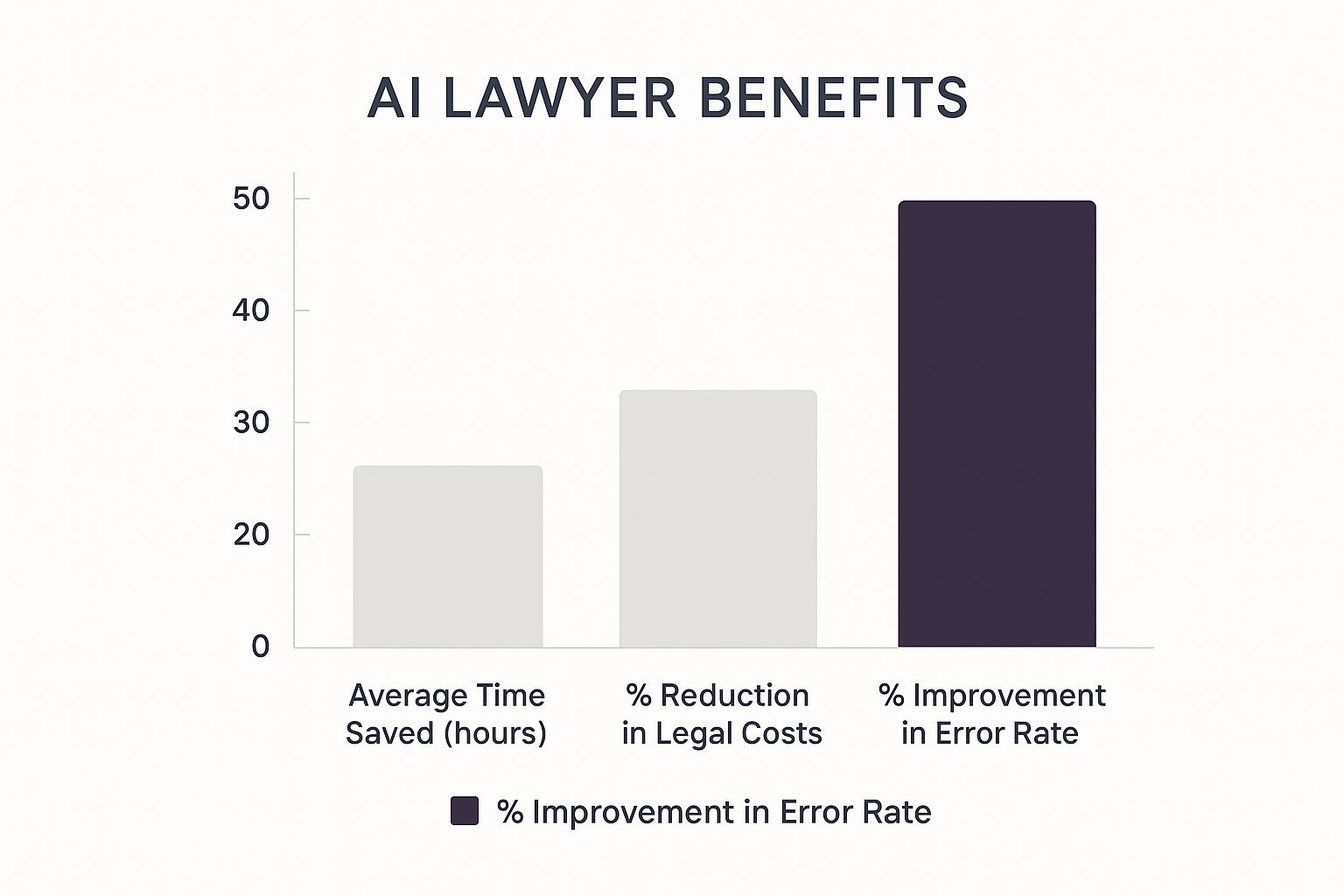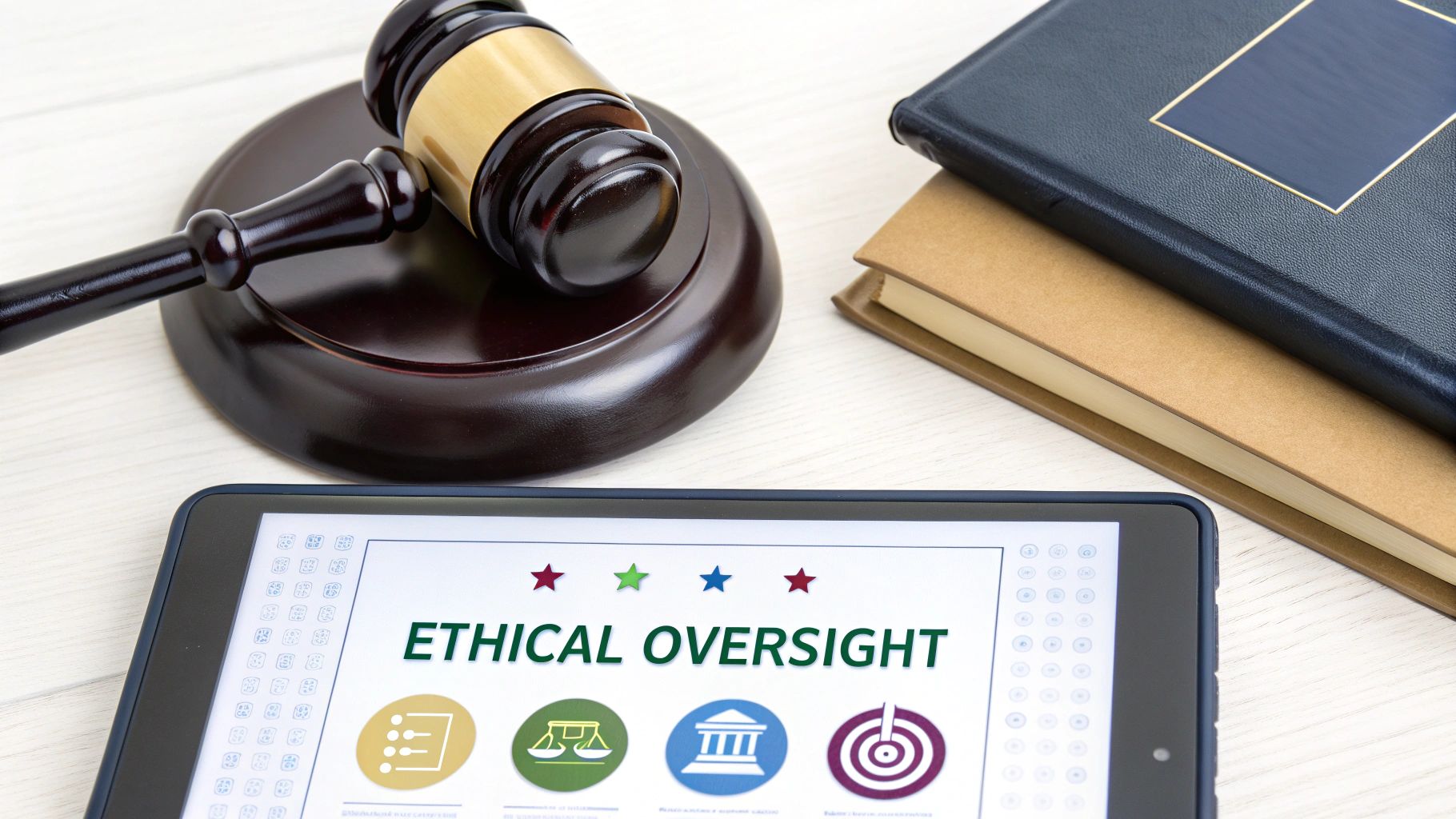What The Heck Is An AI Lawyer (And What It Definitely Isn't)

Let's be clear: an AI lawyer isn't a robot attorney arguing cases in court. That's science fiction. The reality is much less glamorous. Think specialized software designed for legal tasks, not a sentient android. Although, that would be interesting.
So, What Can These Tools Actually Do?
Currently, AI in law focuses on document analysis, identifying patterns, and extracting key information. It's like a highly efficient paralegal on steroids. For instance, AI can rapidly review contracts, highlighting important clauses and potential problems much faster than a human. It's quite impressive at times.
At Cordero Law, we use AI, and I've witnessed firsthand its potential and its pitfalls. Let's just say there have been some learning experiences along the way. AI: it's a mixed bag.
The Good, The Bad, and The Buggy
AI lawyers excel at repetitive tasks like due diligence, basic legal research (though even that can be unreliable), and drafting standard contracts. However, don't expect strategic thinking or complex legal arguments.
And definitely don't ask for ethical advice. My attempt resulted in circular logic and generic platitudes. It was amusing, in a slightly terrifying way.
The Hype Is Real (But So Are the Limitations)
The legal AI market is exploding. It's currently valued at around USD 1.9 Billion and projected to grow by 13.1% annually through 2034. Major players like Thomson Reuters and IBM are investing heavily in this technology. Find more detailed statistics here. But frankly, much of it is overblown.
Most AI legal tools aren't as advanced as vendors claim. They’re useful for specific tasks, but they won't replace lawyers anytime soon. Can you imagine an algorithm arguing a case based on empathy or understanding human emotions? Neither can I.
AI and the Future of Law (More Than Just a Buzzword)
Here’s the key takeaway: AI is changing the legal field. It’s like having a team of tireless research assistants at your disposal. That's the potential. But we're still in the early stages. There’s a lot of hype, experimentation, and learning (sometimes through failure). The key is managing expectations, understanding the limitations, and remembering that law is fundamentally about people. At least for now. And that's something AI can't replicate. Yet.
How AI Is Actually Changing Legal Practice (Like It Or Not)

The infographic above highlights some key metrics about AI in legal practices. It focuses on the average time saved per case, the percentage reduction in legal costs, and the percentage improvement in error rate. The impact on time savings is substantial, and error reduction also gets a significant boost.
The legal field isn’t known for being fast, cheap, or even always accurate. But AI is changing things, ready or not. At Cordero Law, we’re seeing these tools impact our daily work. Contract review used to take up my entire weekend. Now it’s done in a fraction of the time.
Stuff AI Is Actually Good At (No, Really)
Here's a quick overview of where AI is making a real difference:
- Document Review: AI excels at this. It quickly reviews contracts, flags key provisions and inconsistencies—things a human might miss or take hours to find.
- Basic Legal Research: The keyword here is "basic." AI can find relevant cases and statutes faster than manual searches. However, human analysis and interpretation are still necessary. Common sense isn't something AI has mastered yet.
- Generating First Drafts: AI can create first drafts of standard legal documents, like NDAs or simple contracts. This frees up attorneys for more strategic work, like client meetings.
2025 stats show over 54% of legal professionals are drafting with AI, and almost half are using it for research and matter analysis. This significant adoption rate is changing how we practice law. Even partners at traditional firms are taking notice. Explore this topic further.
Let's look at some more detailed statistics on AI adoption in legal practices:
The following table illustrates the current AI adoption rates across various legal tasks, along with reported efficiency gains:
| Legal Task | AI Adoption Rate | Efficiency Improvement |
|---|---|---|
| Document Review | 65% | 45% |
| Legal Research | 48% | 30% |
| Drafting | 54% | 35% |
| Matter Analysis | 45% | 25% |
This data clearly shows that AI is making significant inroads into various aspects of legal work, offering considerable improvements in efficiency.
Where AI Falls Flat (And Sometimes Face-Plants)
AI isn't magic. There are areas where it's not ready for real-world application:
- Negotiations: AI can't understand nuance, context, or emotions—critical aspects of negotiations.
- Courtroom Arguments: AI isn't replacing trial lawyers anytime soon. It lacks strategic thinking, emotional intelligence, and charisma.
- Ethical Considerations: AI can’t provide actual ethical guidance. For that, you still need a human.
It’s important to understand both the potential and the limitations of AI. The hype is real, but so are the limitations. These tools are incredibly useful when used correctly, but they're not a silver bullet. They're not replacing lawyers just yet. There's a lot of value there if you know how to use it right. I’ve seen lawyers thrive using these tools, and I’ve seen others implement very expensive glorified paperweights.
When To Use An AI Lawyer (And When To Run The Other Way)

Thinking about using an AI lawyer? Whether it's for a simple contract review or something more complex, it's important to understand that these tools are not inherently good or bad. They're more like a powerful tool – incredibly useful for certain tasks, potentially risky for others.
AI’s Legal Sweet Spot: Where It Actually Shines
AI legal tools have demonstrated impressive capabilities in specific areas:
- Document Review: AI excels at reviewing lengthy documents. An 80-page lease? AI can quickly identify key clauses and inconsistencies, tasks that would take a human lawyer hours to complete.
- Basic Legal Research: For quick searches of relevant cases and statutes, AI can be a valuable tool. It can quickly provide access to legal information, similar to Westlaw, but often at a lower cost.
- Contract Template Generation: Need a standard NDA? AI can generate one in minutes, freeing up your time for more important tasks like client communication.
To gain further insights into how AI is transforming legal practices, particularly in the area of workflow automation, check out this helpful resource on Legal Workflow Automation.
AI’s Danger Zone: Proceed With Extreme Caution (Or Not At All)
However, there are some areas where using AI is not advisable:
- Anything Emotionally Charged: Cases involving sensitive negotiations or custody battles require emotional intelligence, something AI currently lacks. Using AI in these situations is simply inappropriate.
- High-Stakes Litigation Strategy: Developing effective litigation strategies demands nuanced arguments, strategic thinking, and the ability to read a jury – all areas where human lawyers are essential. The risks associated with using AI in these cases are too significant.
- Complex, Industry-Specific Deals: AI may overlook crucial provisions specific to a client’s industry. Relying solely on AI-generated contracts can lead to serious consequences and missed opportunities.
Our Firm’s Framework: How We Decide (It’s Complicated)
At Cordero Law, we've developed a framework for strategically using AI:
- Does this task involve emotional intelligence or nuanced judgment? If so, a human lawyer handles the task.
- Is the risk of error catastrophic? If so, AI is used only with close human supervision.
- Will AI significantly improve efficiency? If so, we carefully consider integrating AI into the process.
Initially, I was skeptical about using AI in legal practice. However, I've learned that these tools can be incredibly effective when used appropriately. They enhance our services and improve efficiency. But, it's important to remember that AI is not a replacement for human judgment and experience. Knowing the limits of these tools is crucial. AI is changing the legal profession rapidly, and it’s vital to understand its capabilities and limitations.
Show Me The Money: The Real Economics Of AI Legal Tools

Let's talk frankly about the financial realities of AI in the legal field. Vendors often promise dramatic cost reductions, like 80%, and huge efficiency boosts, like 10x. Marketing, right? The reality is more complex. My conversations with numerous firms reveal a wide range of financial outcomes. Some are thriving, while others struggle to find their footing. We've even observed this within Cordero Law. Our corporate team saw immediate returns, while our litigation team took longer to break even.
Pricing Models: Decoding the Fine Print
That "affordable" subscription might have hidden costs. Understanding the pricing models is crucial.
- Per-Document: While seemingly straightforward, these costs can quickly escalate with high-volume tasks.
- Per-User/Month: A common model, but ensure sufficient tool usage to justify the cost per user.
- Tiered Pricing: This model often bases pricing on features or usage limits, making careful examination of the fine print essential.
- Enterprise Solutions: These solutions involve custom pricing, and strong negotiation (potentially with external experts) is advisable.
Hidden Costs: The Unforeseen Expenses
Beyond the subscription fee, other costs often emerge.
- Integration Costs: Connecting AI tools with existing software can incur significant IT expenses and productivity losses.
- Training: Team members need training to effectively use these tools, including time, materials, and managing the learning curve.
- Data Migration: Transferring data to new systems can be a complex and expensive process.
- Ongoing Maintenance and Support: Software requires updates, troubleshooting, and ongoing support, which can add to the overall cost.
The legal AI software market is experiencing significant growth. It's projected to rise from $3.11 billion in 2025 to $10.82 billion by 2030. This growth is fueled by advancements in generative AI for contracts, e-discovery, and virtual assistants. Find more statistics here. This expansion attracts competition, which ideally benefits consumers.
Calculating ROI: Setting Realistic Expectations
Return on investment with AI isn't immediate. It takes time, sometimes years. Consider these factors:
- Practice Area: AI's impact varies depending on the legal field. It can be highly effective in corporate law but more challenging in litigation.
- Client Base: AI excels with high-volume, standardized work, but its effectiveness in niche, complex cases may be limited.
- Current Processes: If your existing systems are inefficient, AI might not be the solution. Optimizing internal processes first is crucial.
Decision Framework: Evaluating the Investment
The question of whether AI is worthwhile is common. Here's a framework for making that decision:
- Identify Your Pain Points: Determine where you're losing time or money.
- Evaluate Available Tools: Assess whether the tools address your specific problems, looking beyond marketing claims.
- Calculate Realistic Costs and Potential Savings: Factor in both the upfront and hidden costs.
- Develop a Phased Implementation Plan: Start small, test, and iterate, avoiding a large-scale, all-in approach.
To understand potential cost savings, let's look at a comparison of traditional legal services versus AI-powered solutions for common tasks:
AI Lawyer Cost Comparison By Legal Task:
Comparison of costs between traditional legal services and AI-powered alternatives for common legal tasks
| Legal Task | Traditional Cost | AI-Powered Cost | Potential Savings |
|---|---|---|---|
| Legal Research | $500 – $2,000 | $50 – $200 | $450 – $1,800 |
| Document Review | $1,000 – $5,000 | $100 – $500 | $900 – $4,500 |
| Contract Drafting | $500 – $2,000 | $50 – $200 | $450 – $1,800 |
Please note these figures are estimates and can vary depending on the complexity of the task and the specific AI tool used.
As the table illustrates, substantial cost savings can be achieved by utilizing AI-powered tools. However, it is crucial to factor in the potential hidden costs discussed earlier.
AI in law isn't magic, but it can be a powerful tool when used strategically. Don't fall for the hype. Conduct thorough research, ask critical questions, and always scrutinize the fine print (or have someone do it for you – it's important).
The Ethical Minefield: Navigating AI Lawyer Liability Issues
This keeps me up at night. Seriously. And it should keep you up at night too if you’re involved with this technology. The legal and ethical implications of AI lawyers are a giant question mark. A Wild West. Early adopters are walking into uncharted territory. It's exciting, but also terrifying.
Who’s To Blame When AI Messes Up? (It’s Complicated)
Let’s say an AI lawyer misses a critical precedent, or worse, gives bad advice. Who is responsible? The programmer? The lawyer using the software? The vendor? Is it a combination of all three? Currently, nobody knows. The laws and professional standards haven't caught up to the technology. That’s a scary place to be.
We're feeding confidential client data into these systems. These are third-party tools with Terms of Service that constantly change. This is a huge concern. We’re dealing with sensitive information: people's lives and businesses. The implications are serious, not to mention the ethical conundrums.
Emerging Ethical Frameworks: Building the Guardrails (Slowly)
I recently served on a bar association committee regarding AI guidelines. It was eye-opening. We're building the airplane as we fly it. The technology is far ahead of the rules. We discussed frameworks for ethical AI use in law, how to handle malpractice issues, and developing risk mitigation strategies. It's essential that we get this right, because the potential for disaster is real.
Some key discussion points included transparency, data security, and maintaining attorney oversight. We’re all trying to balance the benefits of AI with the risks to our clients. It's a tough balancing act. I remember one heated debate about whether AI should be allowed to draft cease-and-desist letters. Some attorneys were vehemently against it, while others saw it as an efficiency gain.
Cordero Law’s Approach: Transparency and Quality Control
At Cordero Law, we believe in transparency. We’re upfront with clients about our AI usage. We also have rigorous quality control (our team calls it the "AI Sanity Check"). We have protocols for using AI tools, including mandatory human review of all AI-generated work, even for simple tasks. Better safe than sorry.
This includes double-checking research, verifying contract clauses, and ensuring everything aligns with our ethical obligations. We’re constantly refining our processes as the technology evolves. It’s a work in progress, but I’m proud of our standards.
Client Disclosure: Keeping It Real
Client disclosure is tricky. Everyone's handling it differently (or not at all). We try to give clients a clear picture of when and how we use AI in their cases. We explain its limitations and ensure they agree. Informed consent is key. It’s like explaining a complex medical procedure. Clients need to understand the benefits, risks, and alternatives.
This whole area of client disclosure is still developing. I wish I had definitive answers, but the legal community is still figuring this out.
Looking Ahead: What Does It All Mean?
The legal landscape is changing rapidly. Lawyers need to stay informed about AI’s ethical and liability implications. This isn't theoretical; it has real-world consequences. State bar associations and even large firms are playing catch-up. This is important – we’re talking about the future of the legal profession.
Cutting Through The BS: Selecting AI Legal Tools That Actually Work
I’ve demoed a lot of legal tech. The difference between what these tools say they do and what they actually do is often enormous. Think of it like the difference between a Lamborghini and a used scooter. Both might get you where you're going, but the experience is vastly different. This section is all about avoiding the hype and saving you money and headaches.
Must-Have Features: Separating the Wheat From the Chaff
First, let's discuss essential features. These aren't just extras; they’re the core components of a truly functional AI legal tool.
- Seamless Integration: If a tool doesn't work with your existing systems, it's practically useless. We learned this the hard way after investing heavily in a document management platform that clashed entirely with our CRM. It was a costly mistake.
- Robust Security: This is non-negotiable. We're dealing with sensitive client data, so security is paramount. Look for encryption, access controls, and compliance with data privacy regulations. Understanding a vendor's AI policy is crucial for ethical compliance and transparency.
- Intuitive Interface: If it requires advanced technical skills to operate, your team won't use it. The tool needs to be user-friendly, simple, and straightforward.
- Reliable Customer Support: Problems inevitably arise. A responsive support team is essential when you need help troubleshooting. Trust me on this one.
Red Flags: Run Away! (Seriously)
Certain red flags should make you run for the hills. Here are some warning signs to watch out for:
- Proprietary Systems: Stay away from closed ecosystems that lock you into a single vendor. Prioritize open APIs and interoperability.
- Overblown Promises: If something sounds too good to be true, it probably is. Maintain a healthy dose of skepticism.
- Lack of Transparency: If a vendor can't explain how their AI works or the source of their data, that's a major problem. It's like a chef refusing to disclose their secret sauce – sketchy.
- Exorbitant Pricing: Don't be swayed by flashy features. Carefully evaluate whether the price justifies the value provided. We almost purchased a research tool that cost more than a car! Thankfully, we reconsidered.
Our Evaluation Framework: How We Test Drive New Tech (Before We Buy)
I've made my share of expensive mistakes, like buying a document review system that couldn't handle PDFs. PDFs! Now, we’re extremely thorough in our evaluation process.
- Pilot Program: We test all new tools with a small team on a contained project. This allows us to assess real-world performance without significant risk.
- Vendor Interviews: We rigorously interview vendors about their technology, security protocols, and future roadmap. We ask the tough questions.
- User Feedback: The team’s feedback is critical. If they don't like a tool, they won't use it. It's that simple.
I've witnessed partners at large firms invest in the latest AI gadgets only to be disappointed by low adoption rates. Success with AI tools isn't about buying the newest toy; it's about thoughtful integration. It's about choosing the right tools, training your team effectively, and managing expectations. That entire process is what truly makes the difference in navigating this challenging but promising legal landscape.
The Future Of AI And Law: What's Coming Around The Corner
Okay, I'm not a fortune teller. My Magic 8-Ball's predictions are questionable at best. But legal AI is changing so rapidly, it's worth considering what's next. So, what's on the horizon? A lot, actually.
Predictive Analytics: Seeing the Future (Maybe)
Imagine knowing a case's likely outcome before it even starts. Predictive analytics aims to do just that. By analyzing massive datasets of case law, these tools identify patterns and predict how similar cases might unfold. Think Moneyball for lawsuits.
I've seen some impressive early versions, though their accuracy needs improvement. This area is about to explode. However, it's not a replacement for sound legal strategy. It's a tool, like a sophisticated calculator that sometimes gives the wrong answer. We're working on that part.
Contract Automation: Goodbye Boilerplate (Mostly)
Contract automation is already changing the game, but we're not done yet. We're talking AI generating complex, customized contracts, not just filling in blanks. Imagine a tool handling everything from drafting and redlining to managing e-signatures.
This means more efficiency, fewer errors, and hopefully lower costs. I suspect this will have the biggest impact soon, mainly because basic contract work is so time-consuming and repetitive.
Explainable AI: Why Did You Do That?
Early AI was a black box. It made decisions, but no one knew why. Frustrating, right? Explainable AI (XAI) is changing that. These systems can explain their reasoning. This is crucial for building trust and understanding AI’s successes and failures.
It's like having an AI intern who can actually answer your questions, instead of staring blankly when you ask about stare decisis. Anyone else have that intern? No? Just me?
The Downside: Risks and Challenges (Because There Always Are)
These advancements are exciting, but let's not ignore the potential pitfalls:
Commoditization of Legal Services: Basic legal tasks could become fully automated. This means increased competition, and lawyers need to figure out how to provide value beyond what a bot can do. We need to be more strategic, creative, and human.
Accessibility Gaps: Larger firms will have more resources to adopt these technologies, potentially widening the gap between the haves and have-nots. The legal community must address this. Justice shouldn't depend on who can afford the best AI lawyer.
The Unknown Unknowns: There are risks we can't even imagine yet. The technology is evolving so fast, and we need to adapt. Continuous learning is key, which is true for the legal profession generally, AI or not.
Look, things are changing quickly. Understanding these trends is crucial for anyone in the legal field, especially in early to growth-stage companies. It's not just about staying ahead of the curve; it's about surviving.
I hope this has been helpful. AI and the law is a wild ride. Buckle up. Ready to explore how we can help you navigate this changing legal landscape? Because, let's face it, it can be a minefield. Contact Cordero Law today! Click here to learn more about Cordero Law.
